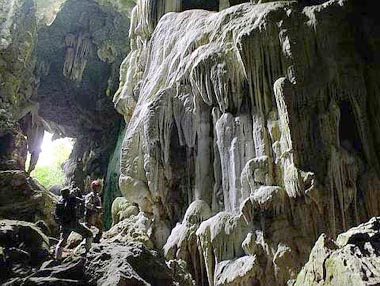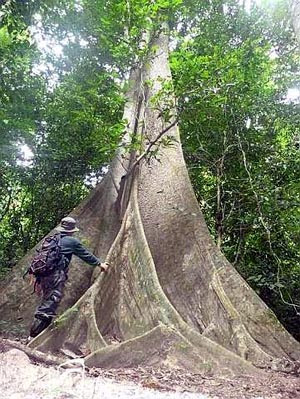How about hiking adventure in Ulu Muda, Kedah?
Wild escapade in Ulu Muda
By Tan Cheng Li
Saturday August 20, 2011
The hidden realm of Ulu Muda astounds a group of nature-lovers.
WE must go. The place is really wild. People have seen tigers there!" exclaimed Lai Choy one evening in May, when we were on a birding trip at Taman Negara Merapoh and were mulling over where to go next.
The mere mention of the word "tiger" had us sold on the idea. So one sunny morning in July, the six of us – Lai Choy, Tuck Kong, LK, Mei, Captain and myself – found ourselves loading our backpacks into three narrow sampan on the shore of Muda Lake near Baling, Kedah.
Our destination was Ulu Muda forest, and leading us into the wilderness tucked away in the north-eastern corner of the state was eco-guide Hymeir Kamarudin. Some six hours earlier, we had set off from Kuala Lumpur for the drive which took us along the North-South Expressway to Gurun, then Sik, Gulai and finally, the lake.

Sight to behold: Wearing of water on limestone has created
impressive formations in Gua Labua, in Ulu Muda forest.
-- Photos by Chou KS
The last leg of the journey was a scenic one as we passed idyllic kampung with plenty of durian and rambutan stalls. Just as our boats set off, a group of sea otters showed up on the lake shore – a promising sign of better things to come, we all declared.
Traversing the lake, we passed forlorn-looking tree trunks that emerge from the depths, the only hint that a forest once sprawled beneath the water body which was formed when Muda River was dammed in 1969 for the irrigation of paddy fields.
The impoundment of the dam, coupled with past logging, have altered the natural landscape here. Nowhere is this more evident than along Muda River as there is none of the huge trees that hang over the river – the type of riverine scenery typical of untouched areas such as seen in Taman Negara, Pahang.
Nevertheless, wild dwellers are still there. Rounding a bend of the river, we startled a herd of wild boars and their striped juveniles. They promptly disappeared into thick foliage. Monitor lizards lumbered on muddy banks while birds darted past us, moving too fast for us to identify them. Trampled riverbanks marked spots where elephants had crossed the stream.
At times, the river turned shallow and boatman Emi had to slowly manoeuvre the boat, so it was almost two hours before we reached Earth Lodge in Kuala Labua. Completed only in April, the state government-built chalets have back balconies that open into the forest. Towering trees, fortunately not felled during the construction, shade the area and provide wild habitat.
From the steps of our chalets, we saw birds (monarch, woodpecker and drongo) and the black bearded gliding lizard flit from tree to tree. Hanging out by the riverside in the evening, we spotted the first of what would be many, many sightings of Ulu Muda's renowned flocks of plain-pouched hornbills. There were some 15 of them, feeding on juicy-looking round fruits (probably figs) on a tree on the opposite bank.
The hornbills were to become the staple of our trip. They showed up every morning and evening, in flocks of threes to 20s. Most times, we saw them fly overhead in V-formation. Ulu Muda is one of only two known sites (the other is Belum-Temenggor forest) where the species gather in huge numbers.
Several forest reserves collectively make up the 160,000ha Ulu Muda forest which stretches into the Malaysian-Thai border.
The ecological wealth of Ulu Muda has long been known. It was proposed as a wildlife reserve and national park as early as the 1960s and 70s. These failed to materialise, and instead, parts of the forest were logged.
In 2002, Kedah wanted to helicopter-log the area but shelved the plan following public outcry.
In 2009, the state government revealed plans for a 27,196ha Ulu Muda state park but this has yet to happen.
Caving delights
The next morning, we awoke to a symphony of forest calls, the loudest of which came from the gibbons. Ulu Muda harbours the agile and white-handed gibbons but these shy primates remain elusive and are not commonly sighted. That morning, we headed into the jungle towards Labua Caves, suitably garbed in leech socks. The blood-suckers literally smothered the trail!
We deduced that the leeches were drawn to the smell of cow hide – how else would you explain why, 10 minutes into the trek, Tuck Kong, who wore leather boat shoes instead of trekking boots, already had some 10 wrigglies crowding around his ankles?
The trail initially followed an old logging road. Ulu Muda was logged between the 1960s and 80s but the Communist insurgency prevented loggers from advancing deeper into the forest. The years of isolation have allowed logged areas to regenerate, and the small trees ignored by chainsaws have since matured into soaring giants. We could not resist stopping for photographs each time we came across a huge buttress. So it was well over two hours later before we reached the caves.
Hymeir, a speleologist who has explored caves for over 20 years, had earlier told us that Gua Labua was among the best he had ever seen, and he did not lie. Where the cliff wall had caved in, there were skylights that brought the sun into hidden chambers, creating dramatic cave scenes. We gawked and gaped at impressive cave formations shaped over millions of years.
Back on the trail later, we heard the calls of the crested argus pheasant ring through the forest, and soon enough, we reached its "dancing ground" right in the middle of the path. To attract the female, the male would clear a spot of all debris to create a "stage" for it to perform by way of displaying its gorgeous plumage. A few dropped feathers hint at the show we had just missed.
Calls of the banded pitta joined the cacophony of forest sounds as we made out way back to our chalets. To nurse our tired limbs, we soaked ourselves in the "jungle jacuzzi" of Sungai Labua which flows just beside the lodge, letting the gurgling ice-cold water massage our aches away.
Night stake-out
That night, three of us opted to spend the night in the hide beside the salt lick. Sira Air Hangat is a rare combination of a hot spring and a salt lick. As hot water bubbles up from the ground, it fills the air with steam. We bravely waded into the stream – the water was scalding hot!
Dusk and dawn are the best times to see animals at salt licks. Unfortunately, it was already dark when we reached the hide; the animals would have gotten their dose of much-needed soil minerals and left. With little chance of seeing animals, Captain and I decided to sleep.
Lai Choy decided to keep vigil – well, kind of. He woke up every half hour or so to scan the salt lick with his torch. But he spotted nothing. At dawn, we scrutinised the area from our high perch but still saw nothing. When we made our way pass the salt lick to reach our boat, we saw the tracks of frequent visitors – tapirs, deer, pigs and elephants. Some prints looked fresh. Guess we were heavy sleepers.
Next up was a shot at "tubing". The riverine vegetation grew more dense, and the river a lot clearer, the further upriver we went. We had entered pristine territory which had eluded loggers. We got down to push the boat several times when it became grounded in shallow waters. Hymeir said the river used to be deeper, with pebbled beds. Now, it had a sandy bottom which he suspected was caused by upstream land-clearing.
The tubing was good fun. Wedged inside over-sized inner tubes of tyres, we slowly floated downriver. The two rapids we passed created some excitement. Otters, monitor lizards, hornbills, pigeons, a falconet, hill mynahs and doves kept us company during the slow cruise.
Arriving at the lodge, a familiar, welcoming scent greeted us – durian! LK, the undisputed durian queen amongst us, had that morning shrewdly given RM50 to the boatman who was sending three other visitors back to the jetty, asking him to buy some durian. And so it was durian for dessert for the next three meals.
On our last evening at Ulu Muda, we parked ourselves on boats moored by the riverbank – "You must build a viewing platform here," we told Hymeir – to wait for hornbills.
The birds did not disappoint us. Across the river, dusky leaf monkeys jumped about in bamboo clumps, and beside us, butterflies and dragonflies danced among the reeds. One red-and-black broadbill showed up in the canopy above. As dusk crept in, the now-familiar jungle orchestra filled the air. It was a tranquil forest moment which I secretly wished would go on forever.
So, never mind that there was no tiger to be sighted (seriously, does anyone know of anyone who has seen, or even heard, a tiger in the forest?). Just being in the pristine wilderness left us with smiles as we drove away from Muda Lake the next morning. We told ourselves that we would be back – same time next year, of course, to coincide with the durian season.
For more on Ulu Muda, go to earthlodgemalaysia.webs.com or e-mail hymeir@gmail.com. -- The Star Lifestyle









0 comments:
Post a Comment